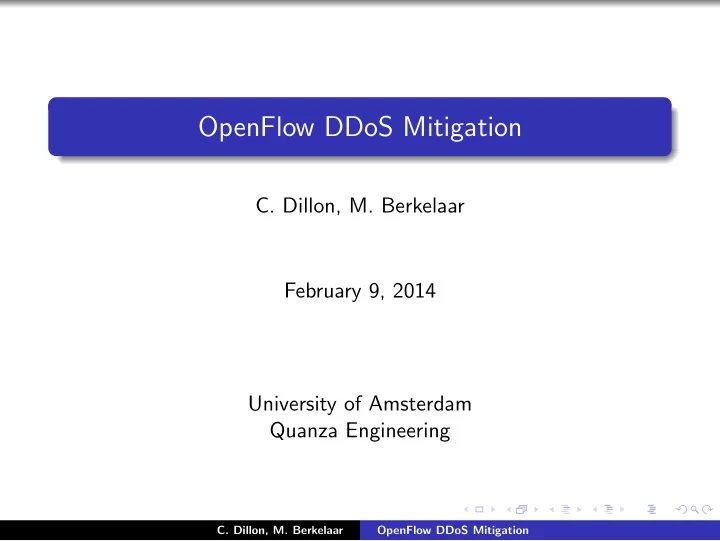

OpenFlow DDoS Mitigation C. Dillon, M. Berkelaar February 9, 2014 University of Amsterdam Quanza Engineering C. Dillon, M. Berkelaar OpenFlow DDoS Mitigation
Introduction Distributed Denial of Service attacks Types of attacks Application layer attacks (low volume) Network layer attacks (high volume) Popular mitigation methods BGP Remotely Triggered Black Hole (RTBH) In-line filtering appliances Scrubbing center OpenFlow DDoS mitigation While keeping the target online C. Dillon, M. Berkelaar OpenFlow DDoS Mitigation
Research Question How can Openflow be used in DDoS mitigation? How can flow statistics be analyzed to detect DDoS attacks? Can packet symmetry in sample traffic be analyzed to detect malicious traffic sources? Can malicious traffic sources be detected by temporarily dropping outgoing traffic? Can OpenFlow be used to efficiently block malicious sources while allowing legitimate traffic? C. Dillon, M. Berkelaar OpenFlow DDoS Mitigation
OpenFlow Separation between control- and data plane Controller creates and pushes flows to data plane TCAM table 0 http://yuba.stanford.edu/cs244wiki/index.php/Overview C. Dillon, M. Berkelaar OpenFlow DDoS Mitigation
OpenFlow: Flow Statistics Per flow: Duration Byte counters Packet counters Polled by controller Network load overview C. Dillon, M. Berkelaar OpenFlow DDoS Mitigation
OpenFlow: Traffic Sampling Packet-in channel Samples to controller Strip payload Encapsulation by switch TCP stream Mirroring Multiple output ports for a flow To any IDS on the network C. Dillon, M. Berkelaar OpenFlow DDoS Mitigation
OpenFlow: Traffic Dropping Flexibility in dropping traffic: Source based blocking Destination based filtering Only block TCP/UDP destination port Limited by capacity of TCAM table C. Dillon, M. Berkelaar OpenFlow DDoS Mitigation
Proposed Solution 1 Initial detection Monitoring flow statistics Detect traffic spikes 2 Identification of attackers Traffic sampling Packet symmetry Block outgoing traffic 3 Blocking the attack Drop traffic from malicious sources C. Dillon, M. Berkelaar OpenFlow DDoS Mitigation
Proposed Solution: Initial Detection Detection of traffic spikes in flow statistics Detection based on the standard deviation Lightweight Initial detection: Used to trigger further detection mechanisms C. Dillon, M. Berkelaar OpenFlow DDoS Mitigation
Proposed Solution: Packet Symmetry Mirror traffic from and to DDoS target Distinguish attackers with packet count symmetry analysis Legitimate traffic shows typical ratios between 1:1 and 8:1. C. Dillon, M. Berkelaar OpenFlow DDoS Mitigation
Proposed Solution: Block Outgoing Traffic A short interruption of the outgoing flow could distinguish bad sources. TCP retransmit interval should increases Typical request-response protocols may show equal behaviour Expecting a declining rate of packets OpenFlow can easily and rapidly modify flows that enable this C. Dillon, M. Berkelaar OpenFlow DDoS Mitigation
Proposed Solution: Block Outgoing Traffic 1 Sample 2 Block + sample 3 Analyse C. Dillon, M. Berkelaar OpenFlow DDoS Mitigation
Proposed Solution: Drop Malicious Traffic Explicit drop flows using OpenFlow Source-based blocking explored Idle drop flows expire automatically C. Dillon, M. Berkelaar OpenFlow DDoS Mitigation
Proof of Concept: Experimentation setup Ryu SDN framework Python based OpenFlow controller Detection mechanisms in the controller Software environment KVM + OpenVswitch Hardware environment Arista 7050 OpenFlow switch 10Gbit simulations Not as flexible as OpenVswitch Traffic simulation Victim and Attacker machines Legitimate + DDoS traffic C. Dillon, M. Berkelaar OpenFlow DDoS Mitigation
Proof of Concept: Packet Symmetry Hping3 flood stalls the Curl C. Dillon, M. Berkelaar OpenFlow DDoS Mitigation
Proof of Concept: Block Outgoing Traffic Timing issues with hardware. Flood never stopped. Curl retransmitted at a declining rate. C. Dillon, M. Berkelaar OpenFlow DDoS Mitigation
Conclusion Using the OpenFlow infrastructure to mitigate high volume attacks shows potential. Hardware currently shows limitations: TCAM table size Timing of OpenFlow operations in our experiment caused issues C. Dillon, M. Berkelaar OpenFlow DDoS Mitigation
Questions Questions? C. Dillon, M. Berkelaar OpenFlow DDoS Mitigation
Recommend
More recommend